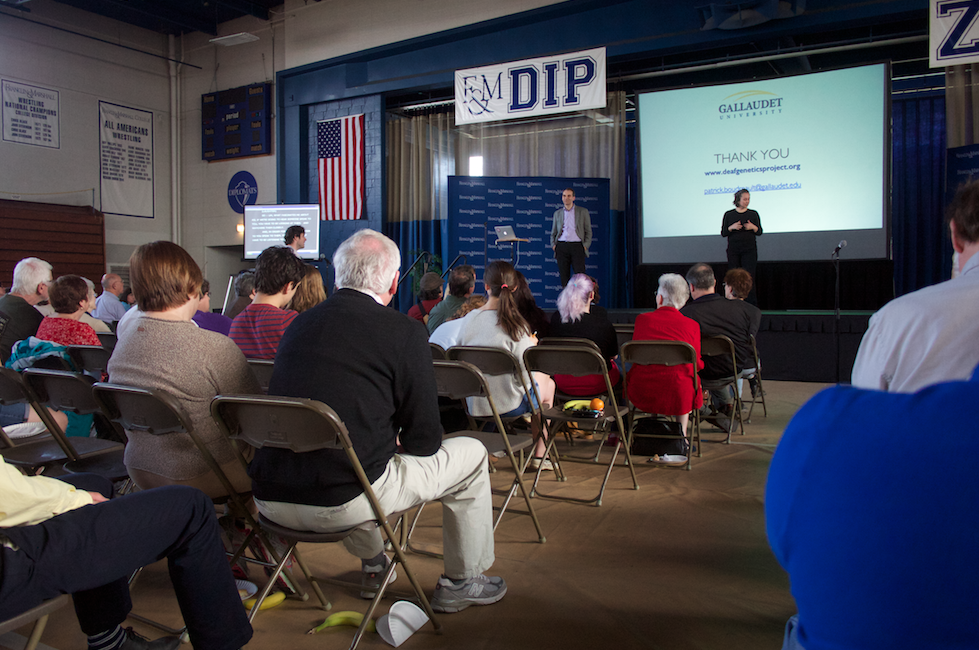
Photo by Emma Brown ’17
By Samantha Greenfield || Senior Staff Writer
This week’s Common Hour was given by Franklin and Marshall’s first deaf speaker, Dr. Patrick Boudreault. He grew up in Quebec in a quadrilingual and bilingual community and is a native speaker of both Quebec and American Sign Language. He gave the talk in Sign Language and had a translator for the audience as well as a projector that displayed the words he was speaking. The topic, Boudreault explained, was linguistics and culture.
In terms of deafness, the United States is the leader as far as access is concerned. And that is mostly because of the Americans with Disabilities Act (ADA) that was established in 1960. “They say that today is an amazing day to be deaf” because there has been so much progress here in America. Boudreault takes pride in the deaf community and deaf culture.
Boudreault explains the term “audism,” which is the “corporate institution for dealing with deaf people, dealing with them by making statements about them, authorizing views of them, describing them, teaching about them, governing where they go to school and, in some cases, where they live; in short, audism is the hearing way of dominating, restructuring, and exercising authority over the deaf community.” It also affects the way in which deafness is researched.
There is a huge impact on genetics in relation to deafness. In 1989 they discovered there was a chromosome a specific gene that they identified as related to deafness, which prompted years of research. In 2002, a lesbian couple wanted to have a deaf baby by choice. This would have created a fifth generation deaf for that family. They succeeded and had a baby girl who is now a freshman in college. The deaf community’s view, according to an article in The New York Times, was proud and understanding of their wish. But there is a view of deafness as a disability so although this couple used science to have a deaf child, the fear is that in the future research will be done to eradicate deafness, and with it the deaf community and culture.
Boudreault then brings up the possibility that all the data used when this lesbian couple chose to have a deaf baby through genetics could be used against the deaf community. Deaf people have been willing to take surveys, provide blood and hair samples to researchers; however, this research could be used to get rid of deafness. He says, “If you’re giving blood today maybe you should stop and think.”
In 2008, in the UK, an act titled “Human Fertilization and Embryology Act” said “people or embryos known to have a genetic abnormality that confers a significant risk of serious medical condition must not be preferred over those not known to have an abnormality.” This would “prevent the use of preimplantation genetic diagnosis to select embryos with genes for deafness,” meaning, “deaf people are less valuable than hearing people.”
Some people want to do a screening to make sure that their babies are healthy. Boudreault says he can understand that, but people want to include deafness in that. Boudreault says that to the deaf community, they consider deafness as defining a group and a culture. So he asks if we could consider this research and acts such as this as a sort of genocide.
His question in the case of the Deaf Genetics Project is: “How should one conduct responsible genetic research in cultural and linguistic minority groups?” So he collects DNA samples and identifies the chromosome 26. So they collect this data and have a conversation with those people that give their DNA that they will use the sample one time and that’s it.
There are two main models of research in terms of deafness. The first is the traditional research model in which the deaf community is not involved. ‘Hearing’ people collect data and get results. His team used a different mode, which was cross-cultural collaboration. This involved the deaf community. So they have the academic cultural perspective, hearing cultural perspective, and the deaf cultural perspective.
Observations: The deaf community is generally resistant toward genetic research and testing on families. They feel that it will devalue deaf people and have a negative impact on their community. But they also want to be more involved when the research is done, which is why Dr. Boudreault is doing this project.
He brings up the United Nation Convention on the Rights of Person with Disabilities and how it was really powerful because it emphasized linguistics, identity, and culture. He goes into three out of thirty of the articles in more detail. Article 2 includes signed languages and other non-spoken languages in the definition of communication and Article 21 includes recognizing and promoting the use of sign languages. Lastly, Article 30 aims for the “recognition and support of their specific cultural and linguistic identity including sign languages and deaf culture.”
He says, “Language is part of the product of our diverse humanity.” The deaf community and Sign Language are part of that diverse community. There are a lot of people who have degenerative hearing and really want this research to help fix this “problem”. But the deaf community worries that this will lead to eradicating deafness and therefore eradicating sign language. Deaf people want the heritage passed down and to preserve their culture.
Boudreault ends by saying that he wants to start a dialogue both here and in classrooms to motivate people to be involved in the deaf community as well as understand it.
